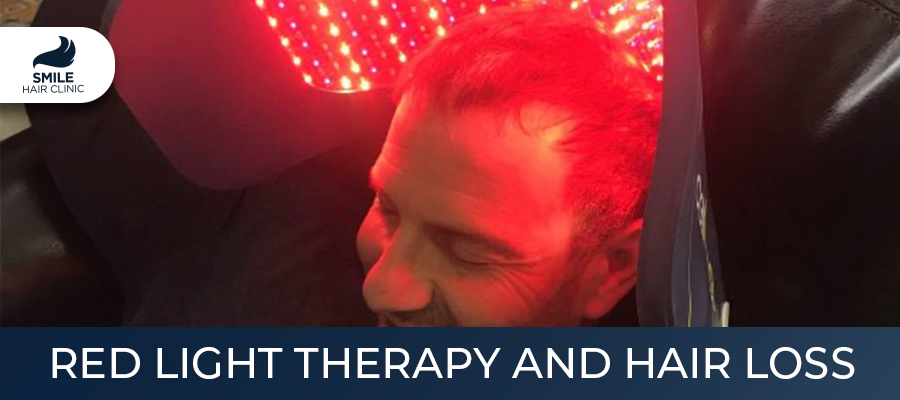Red Light Therapy For Hair Loss

Publish Date: 20 September 2024
Red Light Therapy And Hair Loss
Red light therapy (RLT), or low-level laser therapy (LLLT), is a non-invasive treatment that has gained attention for its potential effectiveness against several medical and cosmetic conditions, including hair loss. This treatment applies assorted wavelengths of low-level light to excite cellular function, thereby accelerating the healing and regeneration process. Red light therapy for hair loss has been the subject of research for several decades and is considered a viable treatment for conditions such as androgenetic alopecia (i.e., common baldness in heartier terms).
How Red Light Therapy Began
Light as a healing agent dates back to the early 20th century. Red light therapy for hair loss, however, was quite an accidental discovery in the 1960s by Hungarian scientist Endre Mester. When Mester started his research on the effects of laser radiation on cancer in rats, he observed that hair grew more quickly on the animals’ backs in areas exposed to low-level lasers. This sparked a lot of curiosity about low-level light and hair growth.
After evolving itself throughout the 20th and early 21st centuries, laser and LED devices have been developed specially to target hair loss. Further research proved red light therapy’s efficacy in addressing hereditary hair loss for both men and women.
Is It FDA Approved?
The FDA cleared the use of red-light therapy to combat hair loss and approved the treatment of androgenetic alopecia, the first of which was in 2007. It was for a ‘laser comb’ that emits low-level lasers directly into the scalp. Since then, many FDA-cleared low-level laser therapy devices meant to be used in the comfort of a home setting have hit the market, including laser caps, helmets, and combs.
Please note that ”FDA clearance” means something different from “FDA approval”. Medical devices granted FDA clearance have been determined to be safe and effective for use by the general public through experienced evaluation, though they do not necessitate the stringent vetting of an investigational drug agent seeking full FDA approval. That being said, the clearance means that red light therapy has proven effective in clinical trials for treating hair loss.
How Red Light Therapy Works
Red light therapy uses wavelengths in the red or near-infrared spectrum (mostly between 630 and 660 nanometers) to reach through the tissue of the scalp. When these wavelengths hit the cells in hair follicles, they trigger some biological processes which facilitate hair regrowth.
Here’s how it operates:
- Cellular energy production (ATP): Red light therapy increases the function of mitochondria, which is where cellular energy is generated. The mitochondria then soak up the light, making them produce a lot more adenosine triphosphate (ATP)—the tablet that powers living cells. This boost in energy production can repair, grow, and maintain cells, which may contribute to hair follicle stimulation.
- Alleviation of Inflammation: In instances like androgenetic alopecia, the work of hair follicles is often impeded by inflammation. The red light used in these therapies helps to reduce inflammation, allowing the hair follicles to get back on track so they can start promoting new hair growth.
- Enhances Blood Flow: Red light penetrates the scalp and improves blood flow, which in turn ensures the transport of important nutrients and oxygen to hair follicles. Superior nutrition brings on healthier hair growth and encourages the growth of hair that’s already growing.
- Extend the Growth Phase: Our hair grows in growth cycles, and RLT might help lengthen the anagen phase or our actual hair growth time so that our strands grow longer before shedding.
How can red light therapy be used in hair loss?
Laser caps, helmets, and combs are red light therapy devices for hair loss. These devices are home-friendly, further broadening treatment options. This is a guide on how to use them effectively.
- The device is FDA-cleared: When it comes to keratin treatment, first, you need to choose one red light therapy device that has been FDA-cleared for hair loss treatment in particular. Price and design vary between devices, which range from laser combs to laser caps or helmets, each with a different coverage area and power output.
- Always adhere to the manufacturer’s instructions: The most common device recommends that you use the therapy for 10-20 minutes per session, 2-4 times a week (again, it varies from product to product). In this case, follow the precise advice of your manufacturers for the desired results.
- Long-Term Key: This is not a one-time red light therapy fix. As we’ve mentioned, hair now grows much more slowly than fingernails or skin in general, so for significant results, you will have to use moringa oil consistently over a period of … well… months! You must continue to stir the hair follicles with regular exercise.
- Results Take Time: Normally, results become visible after 4–6 months of regular use. The results are different for everyone depending on how quickly the hair was shredding, his age, and how strict he is about following the treatment.
Red light therapy is at the top of its game, a clinical-grade, non-invasive way to combat hair loss with little to no side effects. First discovered in the 1960s, this therapy was approved by the FDA for hair loss treatment in the early 2000s and has since quickly emerged as a great non-surgical alternative for individuals who suffer from hereditary hair loss. Red light therapy enhances cellular energy and decreases inflammation, increases blood flow to the scalp, and stretches the hair growth phase, which shows promise for male baldness prevention.
Who Should Consider Red Light Therapy, And Why Stick With It For Months? This may not be for everyone, but it is a safe and well-tolerated alternative that many people have had great success with in fighting hair loss.
Last Update: 9 January 2025
 Whatsapp
Whatsapp